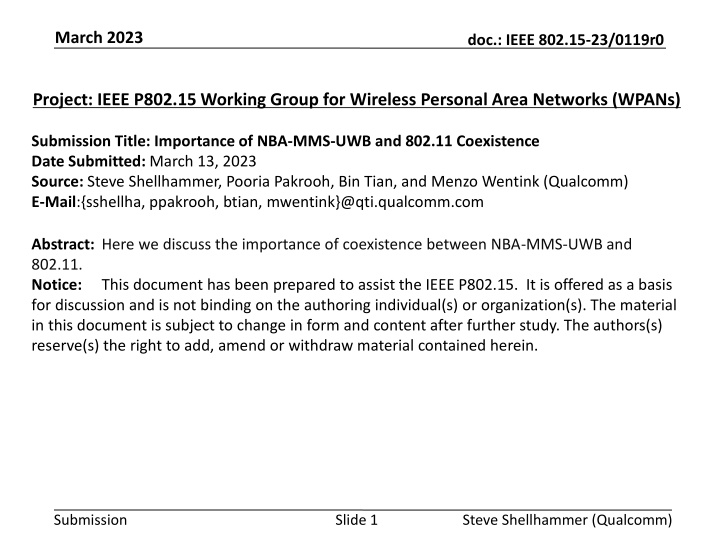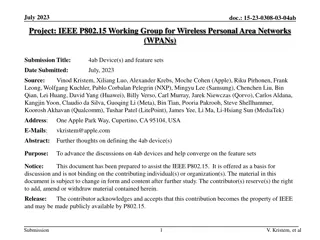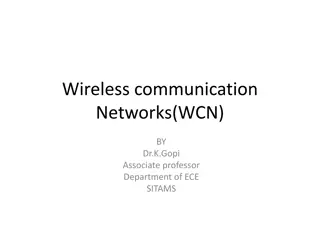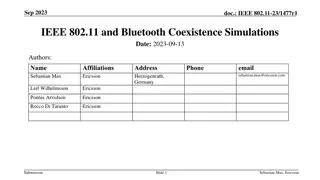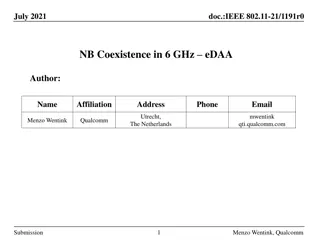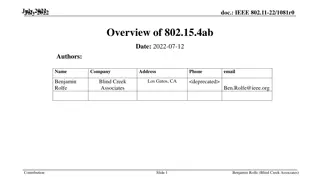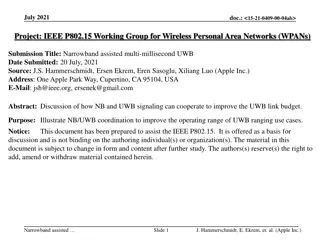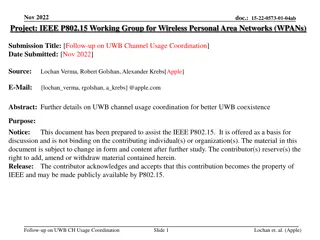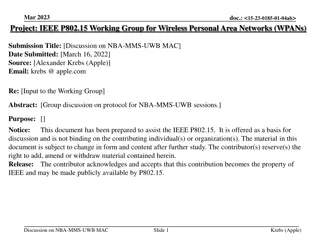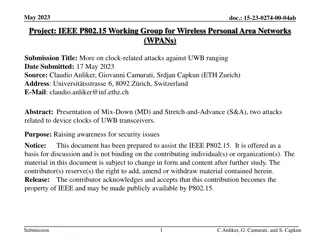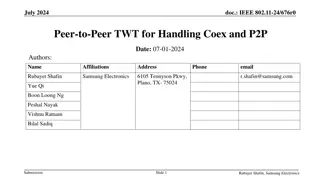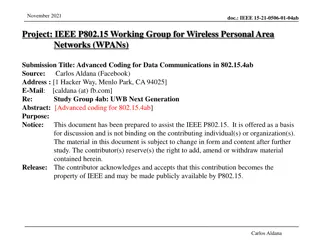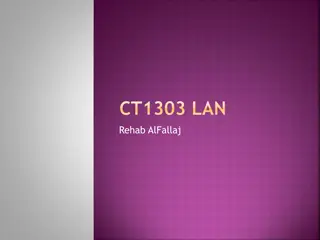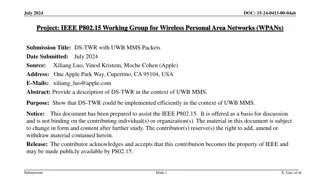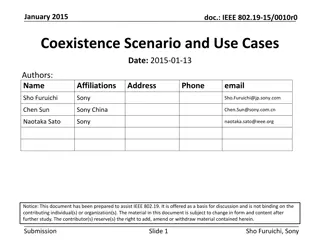Importance of NBA-MMS-UWB and 802.11 Coexistence in Wireless Personal Area Networks
Discussing the significance of coexistence between Narrowband Analog Multi-Media Services Ultra-Wideband (NBA-MMS-UWB) and IEEE 802.11 technologies in shared frequency bands, emphasizing interference mitigation, enhanced ranging capabilities, and other coexistence improvements to support various data use cases while ensuring efficient operation. The document highlights the need for coexistence assessment and mitigation strategies for effective operation within the wireless personal area network (WPAN) environment.
Download Presentation

Please find below an Image/Link to download the presentation.
The content on the website is provided AS IS for your information and personal use only. It may not be sold, licensed, or shared on other websites without obtaining consent from the author.If you encounter any issues during the download, it is possible that the publisher has removed the file from their server.
You are allowed to download the files provided on this website for personal or commercial use, subject to the condition that they are used lawfully. All files are the property of their respective owners.
The content on the website is provided AS IS for your information and personal use only. It may not be sold, licensed, or shared on other websites without obtaining consent from the author.
E N D
Presentation Transcript
March 2023 doc.: IEEE 802.15-23/0119r0 Project: IEEE P802.15 Working Group for Wireless Personal Area Networks (WPANs) Submission Title:Importance of NBA-MMS-UWB and 802.11 Coexistence Date Submitted: March13, 2023 Source: Steve Shellhammer, Pooria Pakrooh, Bin Tian, and Menzo Wentink (Qualcomm) E-Mail:{sshellha, ppakrooh, btian, mwentink}@qti.qualcomm.com Abstract: Here we discuss the importance of coexistence between NBA-MMS-UWB and 802.11. Notice: This document has been prepared to assist the IEEE P802.15. It is offered as a basis for discussion and is not binding on the authoring individual(s) or organization(s). The material in this document is subject to change in form and content after further study. The authors(s) reserve(s) the right to add, amend or withdraw material contained herein. Submission Slide 1 Steve Shellhammer (Qualcomm)
March 2023 doc.: IEEE 802.15-23/0119r0 PAR Objective Proposed Solution (how addressed) Safeguards so that the high throughput data use cases will not cause significant disruption to low duty-cycle ranging use cases Interference mitigation techniques to support higher density and higher traffic use cases Other coexistence improvement Here we discuss the coexistence of NBA-MMS-UWB and 802.11 Backward compatibility with enhanced ranging capable devices (ERDEVs) Improved link budget and/or reduced air-time Additional channels and operating frequencies Improvements to accuracy / precision / reliability and interoperability for high-integrity ranging Reduced complexity and power consumption Hybrid operation with narrowband signaling to assist UWB Enhanced native discovery and connection setup mechanisms Sensing capabilities to support presence detection and environment mapping Low-power low-latency streaming Higher data-rate streaming allowing at least 50 Mbit/s of throughput Support for peer-to-peer, peer-to-multi-peer, and station-to-infrastructure protocols Infrastructure synchronization mechanisms Submission Slide 2 Steve Shellhammer (Qualcomm)
March 2023 doc.: IEEE 802.15-23/0119r0 Background NBA-MMS-UWB utilizes the O-QPSK narrowband PHY operating in the UNI-3 and UNI-5 frequency bands Other technologies, including IEEE 802.11, also operates in those frequency bands We think it is important that these technologies coexist well in those frequency bands A Coexistence Assessment (CA) document is required for the first WG Letter Ballot o So, it is important for 802.15.4ab group to investigate the coexistence issue and develop a mitigation method Submission Slide 3 Steve Shellhammer (Qualcomm)
March 2023 doc.: IEEE 802.15-23/0119r0 Background The NBA-MMS-UWB MAC technical framework document [1] provides a good description of NBA-MMS-UWB There are several possible mechanisms for coexistence between Narrowband operation and other technologies 1. Listen-before-talk (LBT) Document [1] describes how LBT can be applied in NBA-MMS- UWB 2. Channel switching Also covered in [1] 3. Duty cycle To be meaningful for coexistence duty cycle needs to be specified over a short period of time (e.g., one second) Submission Slide 4 Steve Shellhammer (Qualcomm)
March 2023 doc.: IEEE 802.15-23/0119r0 Listen Before Talk (LBT) Listen before talk is an excellent coexistence mechanism, that is widely used for the coexistence between multiple technologies o In some regulatory domains it is required o Standards like 802.11 use both carrier sense and energy detection to identify if the channel is Idle before transmitting in the channel o It is also beneficial for coexistence between Narrowband PHYs o When the channel is Busy there is no benefits to transmitting since the packet will not get through to the intended receiver o Frame-based LBT, as described in [1], fits narrowband operation very well Our strong recommendation is that LBT always be used in NBA-MMS-UWB Ranging LBT and other coexistence mechanisms were discussed previously in [3] Submission Slide 5 Steve Shellhammer (Qualcomm)
March 2023 doc.: IEEE 802.15-23/0119r0 Initial Coexistence PHY Testing Study Here we are focusing on the coexistence of NB O-QPSK and 802.11 We should consider both the PHY and the MAC layers These can be considered using simulations We start with PHY-layer testing to demonstrate the impact of the NB transmission on the WLAN packet error rate o Here we provide some PHY layer results of the effect of a 2 MHz waveform on a 20 MHz 802.11 link o We have BLE waveforms available, which have approximately the same bandwidth as the O-QPSK PHY Submission Slide 6 Steve Shellhammer (Qualcomm)
March 2023 doc.: IEEE 802.15-23/0119r0 PHY Layer Testing For reference we show the bandwidths of BLE and O-QPSK provided in [2] o Below graphs compare 802.15.4 O-QPSK vs BLE 2M GMSK PHY (dashed line) 0 0 802.15.4 O-QPSK BLE GMSK 2M 802.15.4 O-QPSK BLE GMSK 2M Normalized energy outside channel [dB] -5 -10 -10 -15 Attenuation [dBc] -20 -20 -25 -30 -30 -40 -35 -40 -50 -45 -60 -50 0 1 2 3 4 5 6 -4 -3 -2 -1 0 1 2 3 4 106 Channel bandwidth [Hz] 106 f [Hz] Submission Slide 7 Steve Shellhammer (Qualcomm)
March 2023 doc.: IEEE 802.15-23/0119r0 PHY Layer Testing To do the testing we need to select the power level of the O- QPSK signal at the 802.11 receiver We did some free space path loss calculations for the O-QPSK signal From [2] we know o For O-QPSK the maximum output power can go up to 20 dBm o For UNII-3, the maximum output power for non-specific short- range device is 14 dBm (in ETSI) o For UNII-3, if an adequate spectrum sharing mechanism (e.g., DFS and DAA) is implemented, the maximum output power can go up to 26dBm (in ETSI) Higher power is allowed in other regulatory domains (e.g., FCC) Submission Slide 8 Steve Shellhammer (Qualcomm)
March 2023 doc.: IEEE 802.15-23/0119r0 PHY Layer Testing Free space path loss (d meters) 2 4???? ? ??(?) = ???? Assuming ??= ??= 1 and ??= 8 GHz PL(1) = 55 dB, PL (2) = 61 dB, PL (5) = 69 dB The received power for O-QPSK would be: ???= ?? ??? ???= ?? ??? Distance (meters) 41 dBm 35 dBm d = 1 m 47 dBm 41 dBm d = 2 m 55 dBm 49 dBm d = 5 m We will select the case where the TX power is 14 dBm and a two-meter separation. This gives a RX power of 47 dBm. We tested at ?? dBm at the 802.11 receiver, since that data was easily available. Submission Slide 9 Steve Shellhammer (Qualcomm)
March 2023 doc.: IEEE 802.15-23/0119r0 PHY Layer Testing IEEE 802.11 Parameters o IEEE 802.11n (High Throughput, HT) o 20 MHz Bandwidth Channel #1: 2412 MHz [2402, 2422] MHz o One spatial stream o MCS 7 (64-QAM with Rate 5/6 convolutional code) o Sweep WLAN RX power level from 10 to 80 dBm NB Parameters o BLE o 2 MHz bandwidth o Channels 2406 MHz and 2418 MHz o Power level at the WLAN Receiver = 50 dBm Submission Slide 10 Steve Shellhammer (Qualcomm)
March 2023 doc.: IEEE 802.15-23/0119r0 Packet Timing Here is an illustration of the NB (BLE) and WLAN packet timing Submission Slide 11 Steve Shellhammer (Qualcomm)
March 2023 doc.: IEEE 802.15-23/0119r0 PHY Layer Testing Results Here we plot the WLAN Packet Error Rate (PER) for two cases when the Narrowband signal is within the WLAN channel, at 50 dBm We see that the narrowband signal dramatically increases the WLAN PER, when the WLAN RX power is less than 35 dBm Here the PER is less than one, because the duty cycle of the test is such that some of the WLAN packets get through, between the Narrowband packets Submission Slide 12 Steve Shellhammer (Qualcomm)
March 2023 doc.: IEEE 802.15-23/0119r0 Conclusions and Next Steps Conclusions o The NB signal causes high WLAN PER for signal-to-interference ratio (SIR) below around 15 dB to 20 dB o We have provided some PHY Layer Testing results showing that if both the 802.11 signal and the NB O-QPSK signal are simultaneously received at the 802.11 receiver, that there is significant packet error rate, under normal receiver power levels for 802.11 Next Steps o Mitigation methods need to be investigated (e.g., LBT) o WE recommend everyone investigate this coexistence issue so we can conclude on a coexistence mechanism Submission Slide 13 Steve Shellhammer (Qualcomm)
March 2023 doc.: IEEE 802.15-23/0119r0 References 1. Alexander Krebs, et. al., NBA-MMS-UWB ranging text proposal for 15.4ab TFD, IEEE 802.15-22/381r2, February 2023 2. Alexander Krebs, et. al., Narrowband Channel Allocation for NBA-MMS-UWB, IEEE 802.15-22/339r0, July 2022 3. Bin Tian, et. al., Coexistence discussion on narrowband assisted UWB, IEEE 802.15-22/261r0, May 2022 Submission Slide 14 Steve Shellhammer (Qualcomm)
